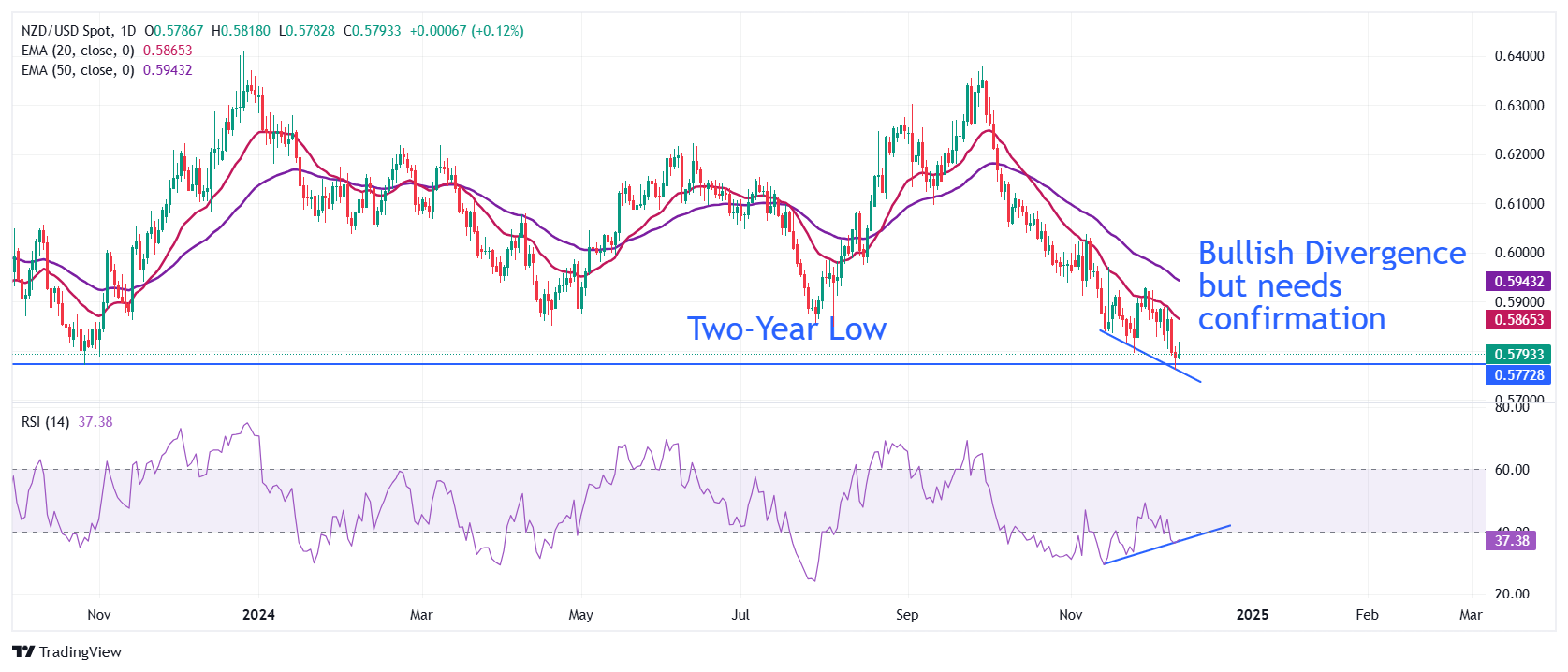- NZD/USD gives up daily gains as US dollar rebounds despite dovish Fed expectations.
- The Kiwi pair is exhibiting a Bullish Divergence formation, but it is unlikely to activate.
- The RBNZ has cut its interest rates by 125bps to 4.25% this year.
The NZD/USD pair gives up its intraday gains and returns below the 0.5800 round figure in the early North American session on Thursday. The Kiwi pair retreats as the US dollar (USD) reverses losses even though traders have priced in that the Federal Reserve (Fed) will cut interest rates by 25 basis points (bp) to 4.25%-4.50% after the two-day monetary policy meeting on Wednesday.
The Kiwi pair has been hit hard for more than two months and is teetering near a two-year low. The asset has faced an intense sell-off as the outlook for the New Zealand Dollar (NZD) has weakened, as the Reserve Bank of New Zealand (RBNZ) has aggressively reduced its Official Cash Rate (OCR) by 125 basis points (bp) up to 4.25% in three policy meetings.
The RBNZ was forced into an aggressive easing cycle due to slowing inflationary pressures, weakening labor demand and poor business activity.
Meanwhile, the US dollar is performing strongly overall on expectations that President-elect Donald Trump’s policies of higher import tariffs and lower income taxes will be inflationary for the United States (US) economy.
The NZD/USD daily chart shows a Bullish Divergence formation, suggesting a slowdown in selling momentum resulting in a reversal move. While the asset has formed a lower low formation on a daily time frame, the 14-day Relative Strength Index (RSI) has made higher lows. The formation needs confirmation to trigger a bullish reversal.
A decisive break above the Nov 29 high of 0.5930 could confirm a reversal setup and push it higher towards the Nov 15 high of 0.5970 and psychological resistance of 0.6000.
However, chances of a bullish divergence confirmation are weak due to unfavorable New Zealand fundamentals, which could take the Kiwi pair lower to the November 2022 low of 0.5740 and the round level support of 0.5700. if it breaks below the two-year low of 0.5770.
NZD/USD daily chart
New Zealand Dollar FAQs
The New Zealand Dollar (NZD), also known as the Kiwi, is a well-known currency among investors. Its value is largely determined by the health of the New Zealand economy and the policy of the country’s central bank. However, there are some peculiarities that can also cause the NZD to move. The evolution of the Chinese economy tends to move the Kiwi because China is New Zealand’s largest trading partner. The bad news for the Chinese economy will likely mean fewer New Zealand exports to the country, which will affect the economy and therefore its currency. Another factor moving the NZD is dairy product prices, as the dairy industry is New Zealand’s main export. High dairy prices boost export earnings, contributing positively to the economy and therefore the NZD.
The Reserve Bank of New Zealand (RBNZ) aims to achieve and maintain an inflation rate of between 1% and 3% over the medium term, with the aim of keeping it close to the midpoint of 2%. To do this, the bank sets an appropriate level of interest rates. When inflation is too high, the RBNZ raises interest rates to cool the economy, but the move will also drive up bond yields, making investors more attractive to invest in the country and thus boosting the NZD. On the contrary, lower interest rates tend to weaken the NZD. The so-called rate differential, or what rates in New Zealand are or are expected to be compared to those set by the US Federal Reserve, can also play a key role in the movement of the NZD/USD pair.
The release of macroeconomic data in New Zealand is key to assessing the state of the economy and can influence the valuation of the New Zealand Dollar (NZD). A strong economy, based on high economic growth, low unemployment and high confidence is good for the NZD. High economic growth attracts foreign investment and may encourage the Reserve Bank of New Zealand to raise interest rates if this economic strength is accompanied by high inflation. Conversely, if economic data is weak, the NZD is likely to depreciate.
The New Zealand Dollar (NZD) tends to strengthen during periods of risk appetite, or when investors perceive overall market risks to be low and are optimistic about growth. This usually translates into a more favorable outlook for commodities and so-called “commodity currencies” such as the kiwi. Conversely, the NZD tends to weaken during times of market turmoil or economic uncertainty, as investors tend to sell riskier assets and flee to more stable havens.
Source: Fx Street
I am Joshua Winder, a senior-level journalist and editor at World Stock Market. I specialize in covering news related to the stock market and economic trends. With more than 8 years of experience in this field, I have become an expert in financial reporting.








